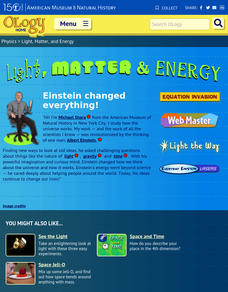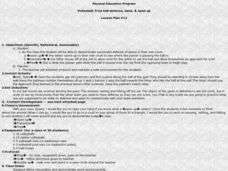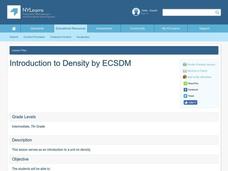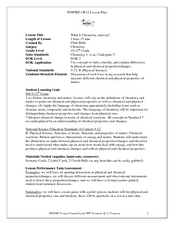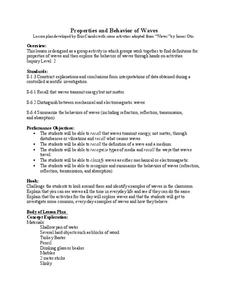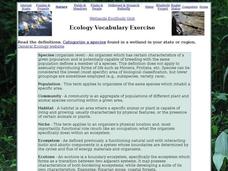American Museum of Natural History
Light, Matter and Energy
Let Einstein's work shine the way. Pupils read about Einstein's iconic equation, E=mc^2, using a remote learning resource and see how ideas from other scientists such as Kepner, Curie, Galilei, and Newton led to its discovery. They...
American Museum of Natural History
Space and Time
Carve out some time to learn about space-time. Young scientists use a remote learning resource to read up on the relationship between space and time. They consider the idea of relativity, see how objects with a large mass can bend space...
American Museum of Natural History
Train of Thought
Hop aboard the train of thought. A remote learning resource has learners consider thought experiments to consider scientific theories. It provides two examples, one on orbiting bodies and the other on the speed of light, for them to work...
Curated OER
Survival Strategies and Adaptation in Insects
Third graders investigate insects and their adaptations that help them survive. For this survival strategies lesson, 3rd graders view photographs of insects and discuss the adaptations that each one uses to survive, including camouflage...
Curated OER
Volleyball - Lesson 11 - Free Ball Defense, Base, and Open Up
What positions should the volleyball players be in for a free ball? What position should they be in for a hard hit? Then where do they each move, transitioning to offense? Lesson 11 goes over these questions regarding positioning and...
Curated OER
Sound Vocabulary
Enhance your unit on sound waves with this word scramble. Fifteen terms are available for physics learners to unscramble. Have them write the definition for each as homework.
Curated OER
Writing Prompts for High School
Are you teaching a high school language arts class and stumped for writing topics? Five pages of writing prompts for all kinds of writing should help you out. Many of these prompts refer to texts that are not included in this resource,...
Curated OER
Introduction to Density
Seventh graders define density in their own words. In this physics lesson, 7th graders solve density problems using its mathematical formula. They explain why some objects flow and some sink.
Curated OER
Alternative Energy
Students identify the five major alternative energy sources. In this physical science lesson plan, students assess the advantages and disadvantages for each type of energy. They complete a concept map using information they researched.
Curated OER
What Is Chemistry, Anyway?
Students differentiate physical and chemical change. In this chemistry lesson plan, students list examples of those changes. They apply what they learned in a Jeopardy style team game.
Curated OER
Properties and Behavior of Waves
High schoolers explore the different properties of waves. In this physics lesson, students differentiate mechanical and electromagnetic waves. They explore each lab station and write their observation about the wave behavior they see.
Curated OER
All Creatures Microscopically Small
Students investigate physical and behavioral characteristics of different microbes and create research- based 'Microbe Biographies.' students compare microbe sizes and examine how size of a microbe relates to its physical and behavioral...
Curated OER
Exploring the Web of Life
Students develop a classroom definition of and explore ideas related to ecosystems. They create a food web using pictures and yarn.
Curated OER
Circulatory System: The Beat Goes On!
With schools focusing on physical fitness activities, now is the perfect time to teach students about the circulatory system.
Curated OER
Science- Unit on Matter- Liquids-
Second graders discover that everything is made of matter. they determine the properties of liquids and that like solids, liquids can be grouped or classified according to properties or qualities. they assess that solids have a definite...
Curated OER
Ecology Vocabulary Exercise: Wetlands
In this ecology vocabulary exercise: wetlands instructional activity, students read the definitions of 8 words, then categorize a species found in a wetland in their region. This page has numerous links to helpful web resources.
Curated OER
Nutrients
Fourth graders understand the important nutrients in food and the value of each. In this nutrients lesson, 4th graders complete a chart giving examples of foods that contain that nutrient and a definition of the nutrient. Students...
Curated OER
Movie Genres
For this grammar worksheet, students match twelve movie genres with their appropriate definitions and examples from two answer banks and then translate the titles into Chinese. Students answer six questions regarding personal movie...
Curated OER
Introduction to Materials Science - Part B
Students are able to give specific examples of what to do and what not to do during given safety situations, and classify materials as metals, polymers, ceramics/glass, or composites. They are able to distinguish between chemical and...
Curated OER
Straw Breathing Exercise
Students fill out an anonymous questionaire to explore whether they might have asthma. They then set up a spreadsheet to enter the data, decide on a definition of asthma, and figure out the prevalence of asthma. Pupils simulate what it...
Curated OER
Influential Scientists Vocabulary Quiz
For this science vocabulary worksheet, students match the names of 19 science professionals with the definition. Example: Ichthyologist (studies fish).
Curated OER
Hot Cans and Cold Cans
Students investigate the physics of heating and cooling through conduction, convection, and radiation. Working in groups, they determine the best way to cool a can of water and warm a can of water. Temperature is taken at five minute...
Curated OER
Mineral Identification
In this mineral identification lesson plan, learners analyze 14 minerals and test their physical properties. They test the color, luster, streak, hardness and breakage of each mineral. Students answer 5 questions about the physical...
Curated OER
Creating Characters
Students examine the methods of effective characterization. In this writing skills lesson, students discuss how emotions, dialogue, actions, and physical descriptions build believable characters. Students then use the methods of...
